NCERT Solutions for Class 9 English Literature Reader Chapter 6
Unit-6 : Solutions of Questions on Page Number : 57
Q1 : Can you match the following?
(a) Something that lives for one year-biennial
(b) Something that lives for about two years-perennial
(c) Something that lives for more than two years-annual
Answer :
(a) Something that lives for one year-annual
(b) Something that lives for about two year-biennial
(c) Something that lives for more than two years-perennial
Q2 :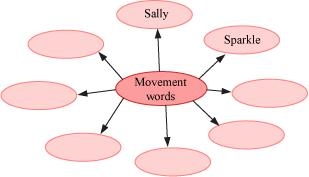
Answer :
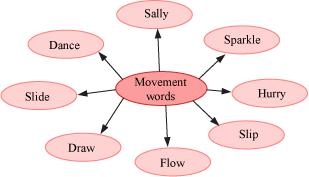
Q3 :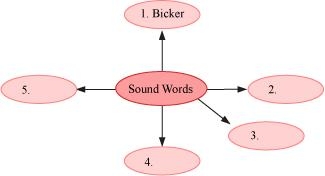
Answer :
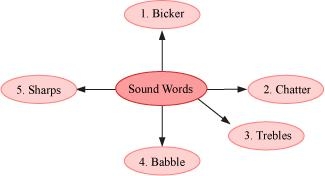
Q4 : A word or a combination of words, whose sounds seems to resemble the sound it denotes (for example: “hiss”, “buzz”, etc.) is called onomatopoeia. From the words that you have filled in the blurbs above, point out these words.
Answer :
Bicker, Chatter, Babble
Q5 : The following is a flow chart showing the course of the brook. Can you fill in the blank spaces with help from the phrases given below?
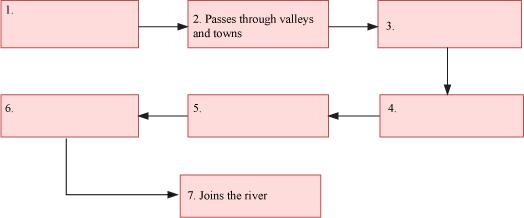
(a) Passes under fifty bridges; (b) comes from the place where coots and herons live; (c) passes lawn filled with flowers; (d) crosses both fertile and fallow land; (e) goes through wilderness full of thorny bushes
Answer :
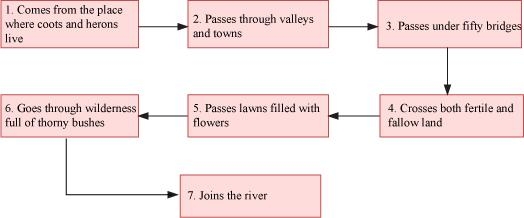
Q6 : The message of the poem is that the life of a brook is ___________.
(i) temporary
(ii) short-lived
(iii) eternal
(v) momentary
Answer :
(iii) eternal
Q7 : The poet draws a parallelism between the journey of the brook with ___________.
(i) the life of a man
(ii) the death of man
(iii) the difficulties in a man’s life
(iv) the endless talking of human beings
Answer :
(i) the life of a man
Q8 : The poem is narrated in the first person by the brook. This figure of speech is ________.
(i) Personification
(ii) Metaphor
(iii) Simile
(iv) Transferred epithet
Answer :
(i) Personification
Q9 : In the poem, below mentioned lines:
“And here and there a lusty trout ,
And here and there a grayling”
suggest that _____________.
(i) the brook is a source of life
(ii) people enjoy the brook
(iii) fishes survive because of water
(iv) the brook witnesses all kinds of scenes
Answer :
(i) the brook is a source of life
Q10 : How does the brook ‘sparkle’?
Answer :
The brook sparkles because of the sun’s rays which shine on its water. The sudden emergence or rush of the brook is shown to be in a sparkling motion.
Q11 : ‘Bicker’ means ‘to quarrel’. Why does the poet use this word here?
Answer :
‘Bicker’ means a noisy discussion or an argument. The poet uses the word ‘bicker’ to describe the noisy flow of the brook as it flows through the valley. This here talks about the flow of the course of the brook with a gentle repetitive noise.
Q12 : How many hills and bridges does it pass during is journey?
Answer :
The brook passes thirty hills and fifty bridges during its journey.
Q13 : Where does it finally meet the river?
Answer :
The brook, after crossing ridges, villages, towns and bridges, finally reaches Philip’s farm to join the river.
Q14 : Why has the word ‘chatter’ been repeated in the poem?
Answer :
The word ‘chatter’ has been repeated in the poem because it represents the sound frequently made by the flowing brook. It seems that the brook talks about its journey that it has travelled throughout in a lively mood.
Q15 : With many a curve my banks I fret’- What does the poet mean by this statement?
Answer :
‘With many a curve my banks I fret’ is a reference to the erosion of the bank by the curvaceous movement of the river.
Q16 : ‘I wind about, and in and out.’ What kind of a picture does this line create in your mind?
Answer :
‘I wind about, and in and out’ creates a picture of a labyrinth in the mind of the readers. The flow of the brook has been mentioned to resemble that of a maze.
Q17 : Name the different things that can be found floating in the brook.
Answer :
The different things that can be found floating in the river are pumice, flowers, wood chips, foamy flakes, bark of trees, twigs and leaves.
Q18 : What does the poet want to convey by using the words ‘steal’ and ‘slide’?
Answer :
By using the words ‘steal’ and ‘slide’, the poet wants to convey the silent and almost undetectable movement of the stream.
Q19 : The poem has many examples of alliteration. List five examples.
Answer :
The repetition of the same sounds or of the same kinds of sounds at the beginning of words or in stressed syllables is known as alliteration.
Five examples of alliteration in the poem are:
‘Sudden sally’
‘Field and fallow’
‘Willow-weed’
‘Golden gravel’
‘Slip, slide’
Q20 : ‘I make the netted sunbeam dance.’ What does ‘the netted sunbeam’ mean? How does it dance?
Answer :
The ‘netted sunbeams’ is a reference to the crisscrossing rays of the sun.
The sunbeams falling on the brook are reflected in various directions, giving the impression that they are dancing.
Q21 : What is the ‘refrain’ in the poem? What effect does it create?
Answer :
In the referred poem, the refrain is:
‘For men may come and men may go
But I go on for ever.’
A refrain is a phrase, verse, or group of verses repeated at intervals throughout a song or poem, especially at the end of each stanza. In this poem, it gives a chant-like quality to the tone the poet is writing in.
Q22 : Who does ‘I’ refer to in the given lines?
Answer :
‘I’ refers to the brook in the given lines where the brook describes its journey through various towns, villages, ridges, bridges and hills to join the river.
Q23 : How does it ‘chatter’?
Answer :
The noise made by the quick flow of the brook is what makes it ‘chatter’. While the river wanders in a wild and natural course, it makes a natural swirling, chattering noise.
Q24 : Why has the poet used the word ‘brimming’? What kind of a picture does it create?
Answer :
Brimming here means to be abundantly filled with water, to the point of overflow. The poet has used ‘brimming’ to indicate the amount of water in the river which the brook joins finally.
It creates a picture of immense volume and abundance.
Q25 : Explain the last two lines of the stanza.
Answer :
The last two lines very well explains the central theme of the poem, that is, the fact that human life is mortal while the beauty of nature remains eternal. The brook says in these lines that human lives come to an end and another generation begins. However, the flow of the brook is continuous and goes on forever. The immortality and permanence of the brook has been compared and contrasted with human life, which is mortal and finishes after a certain span of time.
Q26 : Identity the rhyme scheme of the poem.
Answer :
A rhyme scheme defines a definite pattern of rhyme between lines of a poem or a song. The rhyme scheme of this poem is a b, a b… which is known as alternate rhyme scheme. For instance,
I come from haunts of coot and hern;
a
I make a sudden sally
b
And sparkle out among the fern,
a
To bicker down a valley.
b
Q27 : The poem is full of images that come alive through skilful use of words. List out any two images that appeal to you the most, quoting the lines from the poem.
Answer :
This question is to be answered on the basis of your own understanding, experience and thoughts. It is strongly recommended that you prepare the solution on your own.
Q28 : The brook appears to be a symbol for life. Pick out examples of parallelism between life and the brook.
Answer :
The brook appears to be a symbol for life, which becomes the central theme of the poem. Various instances that can be seen in the poem which draw parallel between brook and life, such as:
When the brook comes out from the mountains, its movement is very noisy and quick and it is in full vigor. It is in a hurry to reach its destination, that is, the river. Similarly, man, in his youth, is very energetic, lively, enthusiastic and full of vigor.
When the brook comes closer to the river, its movement becomes slow and smooth, which can be compared to man in his old age, who becomes very calm, gentle, soft and lethargic.
In the early phase of the brook’s life, it has a very fast motion and it overcomes all the obstacles, stones and pebbles in its way. This nature of the brook can be compared to man in his youth when he is enthusiastic and is ready to face all the challenges that come in his way.
During the course of the brook’s journey, it takes a lot of things along with it like blossoms, silt, gravel and fish. In the same way, man even meets, accompanies and moves forward in life with the people he meets, in the journey of his life.
The only difference between the two can be drawn by the fact that the brook is eternal and has a continuous flow while the human life ends by the arrival of death.